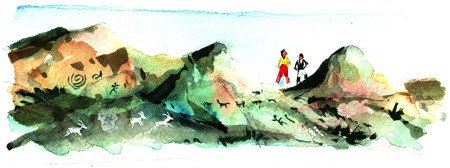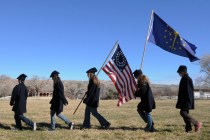Grapevine Canyon great spot for history, recreation

An impressive display of ancient American Indian rock art decorates granite boulders at the mouth of Grapevine Canyon, a desert oasis near Laughlin. Located along the scenic Christmas Tree Pass Road, Grapevine Canyon provides opportunities for hiking, exploring and tailgate picnicking, and is best enjoyed during the cooler months of the year.
Grapevine Canyon lies within Lake Mead National Recreational Area, about 90 miles from Las Vegas. To reach it, head south on U.S. 95 from Railroad Pass through Searchlight to the turnoff toward Laughlin on Highway 163. Follow this scenic highway about 13 miles as it twists through a pass in the rugged Newberry Range. Watch for the turnoff to the graded Christmas Tree Pass Road on the left.
Christmas Tree Pass Road heads north past rugged canyons for several miles before it turns west to climb into the pass through a sparse forest of junipers and scattered pinyons near the summit. Subject to summer flash floods and winter snows, the road through the pass is best traveled by high-clearance vehicles.
Beautiful views eastward across the Colorado River canyon into Arizona await those climbing toward the pass. As you top the pass, the views to the west change to panoramic scenery over the Mojave Desert and many mountain ranges. The road rejoins pavement a few miles south of Searchlight on U.S. 95.
The highest peak in the Newberry Range at 5,639 feet, Spring Mountain lies just north of Christmas Tree Pass Road. The jagged peak dominates an area sacred to the native Yuman cultural groups of the region bordering the Colorado River. Figuring prominently in the religion and heritage of these seven tribes, Spirit Mountain and its surrounding canyons form a Traditional Cultural Property listed on the National Register of Historic Places.
Watch for the spur road toward Grapevine Canyon on the left side of Christmas Tree Pass Road a couple of miles from the Laughlin highway. The road takes visitors to a parking area and a trailhead. A trail heads west about three-quarters of a mile, paralleling a major wash. At the mouth of the canyon, huge boulders mark either side of the wash. In years of good rains, a stream tumbles out into the wash between the boulders. Even in years of little rainfall, Grapevine Canyon always has some running water.
Sources of reliable water in a desert were important to the native people of the area. The profusion of petroglyphs etched into the rocks at the canyon’s mouth by aboriginal artists marks the importance of Grapevine Canyon as a water source, but also as a spot of religious significance. The petroglyphs were created over a period of about 1,000 years, from about 1100 A.D. to modern times. Although difficult to date, some of the petroglyphs show the return of desert varnish, a measurable chemical reaction occurring naturally over time.
Visitors recognize depictions of bighorn sheep and other animals, but many symbols remain mysteries. Please do not touch these cultural relics, but by all means take pictures. Most of the petroglyphs are on easily seen exposed surfaces. A few hide in crevices. Others may be buried in the loose material at the base of the boulders in the wash. Hikers following the stream toward its source a couple of miles up the canyon may spot other decorated rock faces.
Hiking along the course of the stream proves challenging in spots where the water and gravel carried by the stream have polished the rock surfaces shiny and slick underfoot. Springtime often brings enough water that small waterfalls create pools deep enough for wading and splashing. The walk up the creek may be impeded by summertime’s thick growth of vegetation, including tangles of the wild grapevine for which the canyon was named.
Here and there, cottonwood trees thrive, their leaves turning golden at this season. When winter night temperatures drop to freezing, ice rimes the edges of the pool and freezes the seeps into ice sheets or icicles. Whatever the season, visitors are sure to spot birds and other wild creatures drawn to the canyon’s water, cover and food sources, the same attractions that drew the canyon’s first human visitors long ago.
Margo Bartlett Pesek’s column appears on Sundays.


















